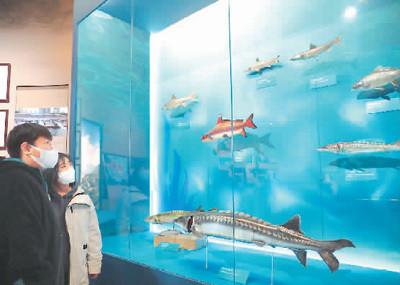
Visitors admire fish specimens from the Yangtze River. Photo by Du Jianpo
When you think of the Yangtze River, what comes to mind? It is the ancient singing of "the great river goes east", the cultural sites such as Liangzhu and Sanxingdui, and the Three Gorges Project of "High Gorge Out of Ping Lake"...
A few days ago, the National Museum of China and the China Three Gorges Group Co., Ltd. jointly launched the "Jiangtian Wanli - Yangtze River Culture Exhibition", based on the collection of the National Museum, bringing together more than 300 sets of representative materials of the Yangtze River culture, comprehensively displaying the history of the Yangtze River, the grandeur of humanities, the beauty of ecology and the greatness of the project.
The Yangtze River is the largest river in China and the third largest river in the world. It originates from the Qinghai-Tibet Plateau Gradan East Snow Mountain, through Bashu, through Jingchu, through Ganwan, through Wuyue, rushing into the sea. The Yangtze River has provided rich nourishment for the endless life of Chinese civilization. The rise and fall of the Yangtze River is closely related to the national economy and people's livelihood. Today's Yangtze River Economic Belt involves 11 provinces and cities in China, with a population size and economic aggregate accounting for half of the country's "rivers and mountains", and is one of the most important industrial corridors in China.
This exhibition is another important attempt by the National Museum to refine and display the spiritual identity of China's excellent traditional culture. The exhibition spans a long time, the content is rich, the exhibits are diverse, and the exhibited cultural relics such as "Yangtze River Map", "Yangtze River Wanli Map", "Detailed Map of Qianlong's Sixteen-Year Southern Tour", "Southern Yunnan Salt Well Map" and so on are exhibited to the public for the first time in recent years.
The exhibition is divided into five sections. The first part, "Crossing the Flow of The Ancient Ages", mainly tells about people's understanding and exploration of the source of the Yangtze River for thousands of years, and uses ancient paintings such as "Yangtze River Map", "Yangtze River Wanli Map", "Yangtze River Atlas" and other ancient paintings to show the grand momentum of the East Stream of the Yangtze River. Painted in the eleventh year of Qing Xianfeng (1861), the "Ten Thousand Miles of the Yangtze River" is a long volume of blended scenes, which not only depicts the scenery on both sides of the river from Minshan to the estuary of the Yangtze River, but also marks texts and quotes poems at each important place, integrating the author's imagination and emotions, which is the expression of the Chinese literati doctor's "lying in the landscape" to send love to the world.
The second part, "The Inheritance of Civilization Continues to Extend", shows the historical context of the continuous development of the Yangtze River civilization more comprehensively. From the stone tools of guanyin cave in western Guizhou in the Paleolithic era, to the stone carvings of Liangzhu Yubi, Liulinxi, and sanxingdui bronze masks... The cultural heritage scattered on both sides of the Yangtze River tells the story of the civilization journey of the ancestors to the glory of the road. In this unit, the audience can see one of the "treasures of the town hall" of the National Museum, "Qianlong South Tour Map". This time, the exhibition is volume 5, which depicts the Qianlong Emperor taking a boat from Jinshan to Jiaoshan, all the way to visit the yangtze River. In the picture scroll, the vast Yangtze River, the waves rolling, the water and the sky are colorful, and the horizon is endless.
The third part, "The Thousand-Year Context of Ancient and Modern", shows the culture and art of the Yangtze River Basin, the characters of the wind, the academy library, the ancient town houses and the unique natural scenery with colorful cultural relics and artworks.
The fourth part is "Golden Waterway Through Kyushu". The Yangtze River is the largest inland waterway transportation network in China, with a circulation mileage of about 71,000 kilometers, known as the "golden waterway". This section describes the far-reaching impact of the Yangtze River on the political, economic and cultural development of the whole of China, especially in the southern region, and introduces the history of Yangtze River shipping and the brilliant achievements of Yangtze River shipping after the founding of New China.
The fifth part, "Monument to the Great River Anlan", reviews the treatment of floods in the Yangtze River from ancient times to the present, focusing on the great achievements of the Three Gorges Project, as well as the achievements and prospects of the protection of the Yangtze River at the historical starting point of comprehensively promoting the development of the Yangtze River Economic Belt. The model of the Three Gorges Dam in the exhibition hall attracted many spectators to stop and take pictures. The display of the achievements of cultural relics protection and ecological protection in the Yangtze River Basin makes people look forward to the future of the Yangtze River.